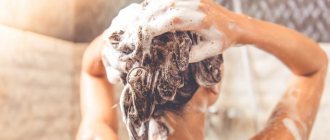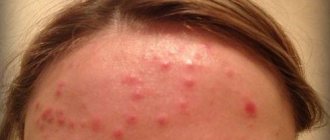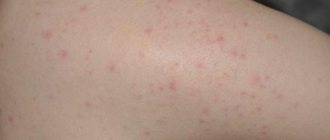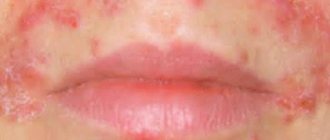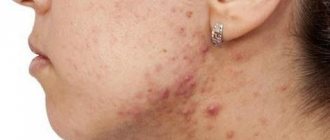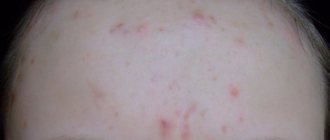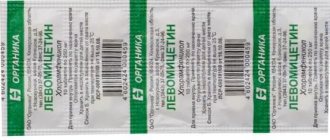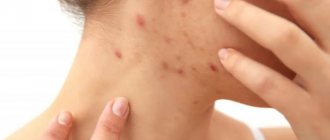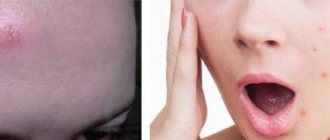Bangs or visible inflammation? We choose the third option: beautiful, smooth skin.
Anna Marukyan
Cosmetologist, dermatovenerologist, experience more than 6 years
Ask a Question
Small, large, red, white, subcutaneous pimples on the forehead are a common and very unpleasant skin defect. Almost every woman faces this cosmetic problem.
Such rashes should not be ignored, since there are many sebaceous glands in the forehead and temples, the inflammation of which can lead to large areas of acne.
Pimples and acne on the temples
Acne is considered to be a temporary youth problem, they say, with the normalization of hormonal processes it will disappear on its own. This statement is not true, and often the occurrence of rashes signals serious problems in the body.
Causes of pustules
The following factors are responsible for the appearance of acne on the temples:
- changes in hormonal levels during pregnancy or puberty;
- ignoring daily hygiene, not completely removing makeup;
- taking antibiotics;
- mechanical stimuli: hoops, glasses ears, headphones;
- problems with the endocrine system;
- habit of supporting your head with your hand in the temple area;
- seborrheic dermatitis or increased oily scalp.
Frequent acne on the forehead and temples may indicate a malfunction of vital systems.
Which organs should you pay attention to during rashes?
Pay attention in a timely manner to the localization of skin rashes. It’s time to guess which organ may be out of order. A rash on the temples indicates problems with the pancreas or gall bladder. Therefore, treatment of red acne must begin with following a diet and normalizing nutrition in general. One of the causes of rashes on the temples in women is hormonal imbalance caused by a disorder of the endocrine system.
Red pimples in the temporal region often try to warn of problems with the gastrointestinal tract. When the intestines do not cope with their duties properly, the body accumulates a large amount of waste and toxins, which begin to appear in the form of pimples on the temples. Proper nutrition and regular consumption of the right amount of clean water will help normalize the functioning of the digestive system and get rid of acne on the temples.
A disruption of the immune system can cause increased oiliness of the skin of the body and scalp, and as a result, the appearance of acne in the temple area. To strengthen your immune system, you need to change your lifestyle, eat healthy foods, spend more time in the fresh air, exercise, avoid stress and get enough sleep.
A doctor can determine the actual cause of acne on the temples. He will prescribe additional tests and examination of organs that cause suspicion, and after the results obtained, he will tell you how to properly treat the rash.
Traditional Treatment Options
To get rid of acne on the temples of women, modern medicine offers many remedies:
- Ichthyol ointment is a good inexpensive antiseptic that treats red pimples.
- Isotretinoin is a drug that reduces sebum production, reduces inflammation, and helps wound healing after acne.
- Zinerit is a complex action antibiotic to combat rashes; it has a bactericidal, astringent and wound-healing effect on acne on the temples.
- Erythromycin ointment is an antibiotic that perfectly copes with rashes, eliminating itching and redness.
Salon treatments to get rid of acne
Currently, beauty salons are successfully eliminating the problem of rashes on the face. They offer a varied range of procedures and cosmetics to remove acne on women’s temples:
- Microdermabrasion is one of the most painless types of mechanical facial cleansing; it removes dead skin particles as much as possible, provoking the formation of new epidermal cells.
- Chemical peeling removes the upper layers of the skin, launching regeneration processes in it.
- Laser facial resurfacing uses a laser that burns the upper layer of the dermis, eliminating acne and unevenness.
Any of these methods is indicated for the treatment of acne in women; the procedures must be carried out in a course of 4-6 sessions, depending on the individual skin condition.
Traditional recipes for fighting acne
Skin rashes have plagued humanity since ancient times, when traditional medicine was not so developed, so there are a lot of folk methods that can stop the appearance of acne.
Oatmeal mask is a proven remedy for treating acne over the years. To prepare it, take a tablespoon of ground oatmeal and half a teaspoon of chamomile inflorescences, pour boiling water to a mushy state. The mass, cooled to a comfortable temperature, is applied in a thin layer to previously cleansed facial skin, and after 15-20 minutes, washed off with warm water. Moisturizer is applied to the face. Oatmeal cleanses the sebaceous ducts well, absorbs excess sebum, draws internal ulcers out, and with regular use normalizes oily skin. Chamomile is a natural antiseptic that relieves inflammation and tones problem skin.
READ ALSO: How to create a fashionable clothing brand?
Pimples on the temples respond well to treatment with herbal compresses. Prepare a decoction of herbs with the following ingredients: chamomile - 1 tsp. calendula - 1 tsp. sage - 1 tsp. Pour the collection with 1 liter of boiling water and let it brew. When the broth has cooled to room temperature, you need to moisten cotton pads with it and apply it to problem areas in the temporal region. After 5-7 minutes, moisten the new discs and change the compresses. Make at least three shifts in one session. A positive result can be achieved provided that this procedure is performed regularly. Medicinal herbs have excellent bactericidal, anti-inflammatory and wound healing effects, eliminate itching, flaking and redness.
Essential oils help treat skin breakouts. Tea tree oil, rosemary oil, and black cumin oil have proven themselves to be excellent for treating acne in women. Esters have anti-inflammatory and antiseptic properties, regulate the activity of the sebaceous glands, and regenerate damaged areas. When using essential oils, it is necessary to accurately dose the amount; do not use it undiluted, otherwise there is a risk of serious burns. It is recommended to add a few drops to a cream or mask.
Preventive measures for acne on the temples
In order not to provoke the appearance of acne, you must follow a few simple rules:
- Cleanse your face daily using special products, and be sure to remove makeup before going to bed. Carry out scrubbing or peeling procedures at least once a week.
- Eat high-quality foods, avoid flour, fatty, fried and sweet foods. Eat more unprocessed vegetables and fruits, drink clean water.
- Choose cosmetics suitable for a specific skin type. Do not use other people's cosmetics.
- Wash your hair in a timely manner, and if your skin is oily, use special formulations that regulate sebum production.
- If pimples appear on your temples, do not squeeze them out under any circumstances, but start treating them.
Preventing the occurrence of pimples or getting rid of existing ones is a completely feasible task if you approach the elimination of the causes responsibly and perform the procedures regularly. By alternating or using all methods of combating the appearance of acne, you can achieve a positive result.
Pharmacy products
Currently, on pharmacy shelves you can find many medicines that are designed to combat cosmetic imperfections. But old and time-tested drugs are also popular:
Ichthyol, Sulfur and Zinc ointments are inexpensive products with antiseptic and anti-inflammatory effects. Their use must be coordinated with your doctor, as improper use can harm the skin.- The drug Isotretinoin is prescribed to reduce sebum production. It not only eliminates acne, but also promotes rapid healing. As a rule, after using it there are no marks or scars left from deep blackheads and acne.
- The drug Zinerit has wound-healing, antiseptic and bactericidal properties.
- Erythromycin ointment is a powerful anti-inflammatory agent that quickly and effectively copes with rashes of various etiologies and severity.
- Retinoic ointment, Dimexide, is very popular.
- Antihistamines will help prevent the development of an allergic reaction: Loratadine, Claritin, Citrine, Zodak.
During the therapy period, you should avoid sunbathing, going to the bathhouse and solarium. In some cases, cosmetologists advise not to use decorative cosmetics for several days.
Causes of acne on the forehead and temples
The sebaceous glands are responsible for moisturizing the skin. In normal condition, they provide protection to the skin from damage, penetration of microorganisms, and the adverse effects of ultraviolet rays. A large number of sebaceous glands are concentrated in the area of the chin and forehead. The sebaceous secretion is excreted through the ducts. If they become clogged, the substance remains inside. Forms a favorable environment for the accumulation and development of pathogenic microorganisms. In this place, inflammation and pimple appear. Chinese healers claim that rashes on the forehead indicate problems in the functioning of internal organs. The causes of blockage or malfunction of the sebaceous glands are:
- violation of hygiene rules;
- unsuitable cosmetics;
- hormonal disbalance;
- poor nutrition;
- problems in the gastrointestinal tract;
- alcohol.
It is necessary to clean the skin of the forehead from impurities and cosmetics 2 times a day - after sleep, before sleep. Use a scrub once a week to remove dead cells. At the same time, you should not get carried away with cosmetics for facial skin care. They also lead to clogged pores and the appearance of acne. It is necessary to alternate with folk masks to cleanse the face.
Cosmetic care products must be selected according to skin type. And decorative ones, in the form of foundation, powder, should be completely avoided if rashes appear.
Hormonal imbalance occurs under the influence of many internal and external factors. At certain periods of life it is inevitable. For example, during puberty, menopause, pregnancy. Pimples appear on the forehead and temples before menstruation. If the rashes are not associated with these events in life, they may be caused by diseases of the internal organs or failure of vital systems.
An acne rash appears on the forehead and temples when there are problems in the functioning of the spleen, stomach, intestines, bladder, pancreas, and kidneys. Even in the absence of noticeable symptoms of disease, you need to pay attention to your health. The skin is the first to react to any changes, then discomfort, pain, etc. appear. This phenomenon is caused by poor nutrition and bad habits.
READ ALSO: How to properly treat acne on the face and how to avoid mistakes during treatment? We choose drugs according to the recommendations of a dermatologist
Alcohol has adverse effects on the entire body. Often, after a drunken feast, a painful pimple appears on the temples. Evidence of toxic poisoning, albeit to a small extent.
It turns out that a pimple on the forehead or temples is not just a harmless rash, but a signal of a disruption in the functioning of vital systems and internal organs. Simply masking the rash with foundation or covering it with hair will not work. You can get rid of rashes with comprehensive treatment.
Step-by-step instructions for getting rid of acne
The appearance of several pimples on the eve of menstruation does not require intensive treatment. As a rule, they disappear on their own. It is enough to use tincture of calendula, string or chamomile decoction. A product based on tea tree oil helps a lot. Pimples on the temples can appear due to irregular sex life. The situation is also easily corrected. In other cases, the approach to treatment is more serious.
- The first step is to cleanse the body of harmful microorganisms, substances that have accumulated inside the intestines and cause acne on the skin. Normalize nutrition - more vegetables, fruits, fermented milk products, liquids. You can drink mineral water, tea, compote, fruit juice. Avoid coffee, carbonated drinks, and alcohol. Less sweets, spicy, salty, fatty foods.
- The second thing you should pay attention to is immunity. Due to improper functioning of the intestines, the level of beneficial microorganisms in the body decreases and the level of harmful microorganisms increases. This leads to a decrease in the body’s protective functions, loss of vitamins and minerals. You can replenish the supply with special drugs - Laktovit, Bifidumbacterin, Hilak, or just a set of vitamins.
- Hormonal imbalance always affects the regularity of the menstrual cycle in women. If acne on the temples is accompanied by a delay in menstruation or other abnormal phenomena, you should consult a gynecologist. Hormonal imbalance cannot be corrected on your own.
You can get rid of acne using folk remedies, if the rashes are not very pronounced and tend to disappear. A persistent rash that cannot be treated at home can be eliminated with the help of medications after consultation with a cosmetologist.
What to do if acne appears during menstruation?
Firstly, you should not resort to self-medication or prescribe oral contraceptives yourself. Any medications must be selected by a specialist, and he does this based on data from studies conducted. Women with acne always undergo tests to determine their hormonal status.
Secondly, acne is a polymorphic and multifactorial disease that can be triggered not only by hormonal imbalance. It is necessary to find out why it appeared. For example, one of the symptoms of PMS in many girls is an addiction to fatty and sweet foods, which can negatively affect the condition of the skin33.
Traditional methods of therapy
Masks help with acne on the temples and forehead. They are prepared quickly and applied precisely.
- An egg mask with oatmeal helps relieve inflammation, soothe the skin, and normalize the functioning of the sebaceous glands. 1 tbsp. Grind a spoonful of flakes in a coffee grinder. Add to well beaten egg white. Stir and apply to affected areas of skin for 10 minutes.
- A mask made from aloe and honey works quickly. The volume of the product is prepared depending on the size of the rash. A standard mask is prepared according to the recipe: 1 tbsp. spoon of honey, 2 teaspoons of aloe juice, 3 drops of hydrogen peroxide, iodine. Apply to skin for 10 minutes. Aloe can be used as an independent remedy. Cut off the leaves of the plant and store in the refrigerator for about 1 week. Available as needed. Squeeze out the juice and lubricate the pimples on the temples.
- A blue clay mask soothes the skin and relieves inflammation. It is mixed with water, calendula tincture, lemon juice. The consistency of the product is in the form of sour cream. Apply the mask for 15 minutes to the affected areas of the skin.
- Tea tree essential oil relieves inflammation. It is applied pointwise for 5 minutes.
- An effective folk remedy is an aspirin mask. Helps get rid of acne on the temples in a few hours. For example, in the evening there is a party, in the morning the pimple is treated. The skin will be in good condition. Grind 2 tablets into powder, add a few drops of water. Apply the mask for 20 minutes.
To prevent the rash from recurring, skin cleansing is carried out periodically. Masks are made from kefir, eggs, oatmeal, honey, and herbal tincture.
Professional treatment
If the inflammation does not go away or the rash continues to appear, you should consult a specialist. A cosmetologist will be able to choose the right treatment. Therapists will deal with problems of internal organs and the cause of tumors. It should be noted that squeezing out pimples in the forehead and temples is strictly prohibited by all cosmetologists. In this area, the blood vessels are located very close to the surface of the skin. Squeezing can lead to infection and blood poisoning. The usual, simple procedure for getting rid of an unwanted defect on the temples can even lead to death.
Cosmetologists prescribe medications containing hormones if the cause is related to hormonal imbalance. Antibacterial, cleansing agents - if inflammation is caused by infection, blockage of the sebaceous glands.
The appearance of rashes is a phenomenon that accompanies a person throughout his life. At the same time, you should be attentive to your body and respond promptly to the occurrence of a problem.
Diagnostics
At the first signs of acne in the temporal area, you should seek medical help.
It is important not only to correctly determine the cause of the rash, but also to accurately diagnose it. When diagnosing a disease, it is also necessary to identify it from pathologies such as steroid dermatitis and rosacea.
First of all, the dermatologist conducts an external examination of the formations and the skin as a whole. After this, the patient must undergo a number of additional studies:
- general analysis of urine and blood;
- stool analysis for dysbacteriosis;
- biochemistry;
- examination for the level of estradiol, testosterone, hormones.
Phototherapy for acne
Acne is an inflammatory skin disease caused by a disorder in the hair follicles and sebaceous glands.
The possibility cannot be ruled out that acne may occur due to gastrointestinal disorders. Therefore, the specialist can also refer the patient to undergo an endoscopic examination.
The main task of the doctor is to determine the cause that provoked the development of the pathology. This plays a decisive role in the choice of further therapeutic measures.
Causes of acne on the forehead and temples
The main reason why pimples appear and cluster on the forehead and temples is excessive sebum production, which leads to clogged pores.
Sebum protects your skin from environmental damage, but when you produce too much of it, you risk clogging your pores. The pores become clogged, fat cannot come out, and as a result we get fertile ground for the proliferation of bacteria and microbes.
The process of inflammation and suppuration begins, which only gets worse over time. The result is that from a small acne we get a large, festering pimple. How can this be prevented? You need to know your enemies by sight.
The main provocateurs of increased oily skin are: lack of care and cleansing, hormonal imbalances and poor nutrition. If the hairstyle covers the forehead and temples, it can also contribute to the appearance of rashes.
In addition, the causes of acne on the forehead, temples along the hairline, above and between the eyebrows can be:
- Malfunctions of the digestive system are a special group of suspicion . In 30-40% of cases, it is problems and slagging in the gastrointestinal tract that trigger the process of sprinkling on the face.
- Squeezing pimples and frequently touching your face with your hands is reason #2. Yes, yes, when you touch your face with your hands, you transfer bacteria from your hands (of which there are a lot) to your face. I’m generally silent about squeezing, especially with dirty hands.
- An increased level of stress also often causes acne to “dislocate” on the forehead and temples.
- Rash as an allergic reaction or side effect from taking medications and using folk remedies.
- Acne can also be caused by disturbances in the functioning of the heart, spleen, urinary and gallbladder and other organs. In this case, immediate consultation with a doctor is required.
By the way, very often rashes on the forehead and temples are accompanied by pimples on the bridge of the nose. Dear readers, I highly recommend reading the adjacent article, which will help not only get rid of the problem (if there is one), but also prevent it.
Skin care rules
Tips from dermatologists to help reduce inflammation and remove pimples in the temporal region:
- It is not recommended to squeeze pus out of acne, because... this can worsen their condition and stimulate inflammation when infected.
- It is allowed to wash your face no more than 2 times a day using soft foams or gels intended for the care of sensitive, problematic and oily skin;
- regularly consume vitamin complexes containing zinc;
- observe the rules of facial and hair hygiene;
- Do not touch the surface of your face with dirty hands, because this may introduce bacteria and germs;
- drink more clean water (at least 1.5 l), because this helps eliminate toxins.
